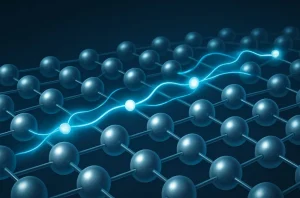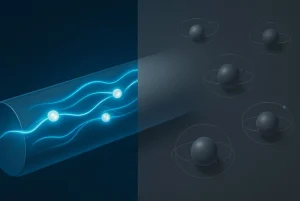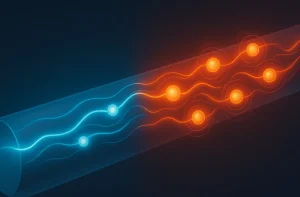Why are metals used in almost every electrical circuit? Why are copper wires hidden inside the walls of homes, and aluminium cables stretched across vast landscapes to transmit power? The answer lies not in chance or convenience, but in the very structure of metals themselves.
Metals conduct electricity better than almost any other type of material, and understanding why reveals fascinating details about atomic structure, bonding, and the behaviour of electrons.
Why Are Metals Good Conductors of Electricity?

Metals are considered good conductors because their electrons are not tightly bound to their atoms. Instead, the outermost electrons, called valence electrons are delocalised.
These free-moving electrons behave almost like a fluid, gliding through the rigid lattice of positive metal ions. This arrangement creates the conditions for electrical conductivity.
When an electric potential difference (voltage) is applied to a piece of metal, these delocalised electrons drift towards the positive terminal.
This drift, though slow at the microscopic scale, results in the flow of current through the material. The efficiency of this process is why metals outperform non-metals and why they are indispensable in every electrical system.
For example, the copper used in domestic wiring has such high conductivity that very little energy is lost as heat, making it an efficient and safe choice for carrying electricity over long periods.
What Is the “Sea of Electrons” in Metals?
The term “sea of electrons” is often used to describe the metallic structure. In metals, the valence electrons of each atom are not restricted to a single nucleus. Instead, they are shared collectively among all the atoms, forming a pool or “sea” that flows throughout the entire metal.
This electron sea provides two important features. First, it creates a strong electrostatic attraction between the free electrons and the positively charged ions, holding the metal together. Second, it allows electrons to move freely, which is the basis for both electrical and thermal conductivity.
This model also explains why metals are malleable and ductile. Because the positive ions can shift within the sea of electrons without breaking the metallic bonds, metals can be hammered into thin sheets or drawn into wires without losing their strength.
A good example is aluminium foil, which can be rolled extremely thin while still remaining intact and functional.
How Do Metals Compare to Non-Metals in Conductivity?

The difference between metals and non-metals is stark when it comes to conductivity. Metals are efficient conductors because of their delocalised electrons.
Non-metals, on the other hand, have electrons that are tightly bound to their atoms. This lack of mobile charge carriers makes non-metals poor conductors, which is why materials like rubber, glass, and wood are used as insulators.
There are, however, exceptions. Graphite, a form of carbon, is technically a non-metal but conducts electricity very well. This is because, like metals, graphite also has delocalised electrons that move freely through its layered structure.
This exception highlights that conductivity is determined not by whether a material is a metal or non-metal, but by the presence or absence of free electrons.
In practice, metals dominate when conductivity is required. Copper wires bring electricity into homes, while aluminium cables transmit energy across long distances. Non-metals serve the opposite purpose, surrounding these conductors with insulation to keep electricity safely contained.
What Is Metallic Bonding?
Metallic bonding is the unique type of bonding that explains both the strength and conductivity of metals. Unlike ionic or covalent bonding, where electrons are shared between specific atoms or transferred from one atom to another, metallic bonding involves a communal sharing of electrons among all the atoms in the structure.
In this bonding, the positive metal ions are arranged in a rigid crystal lattice. Around them, the delocalised electrons form a fluid-like pool that binds the lattice together through electrostatic attraction. This bonding is responsible for several key properties:
- High electrical and thermal conductivity
- Malleability and ductility
- Lustrous appearance, as electrons reflect light
The durability of steel, the shininess of silver, and the usefulness of copper wires can all be traced back to metallic bonding.
Do All Metals Conduct Electricity Equally?
While all metals conduct electricity, some do so far better than others. Conductivity varies depending on the number of delocalised electrons and how easily they can move through the lattice without interference.
The following table compares some common metals by their electrical conductivity and typical uses:
| Metal | Conductivity (relative to copper = 100%) | Common Applications |
| Silver | 106% | High-precision electronics, circuits |
| Copper | 100% | Household wiring, motors, generators |
| Gold | 70% | Connectors, high-end electronics (resists corrosion) |
| Aluminium | 61% | Overhead power cables, aircraft wiring |
| Iron | 17% | Structural applications, machinery |
Silver conducts best but is far too expensive for widespread use. Copper strikes the right balance between efficiency, availability, and cost, which is why it dominates electrical systems. Aluminium, although less conductive, is valued for its low weight and is common in power transmission.
How Does Temperature Affect the Conductivity of Metals?

The conductivity of metals is not fixed. It changes with temperature. As temperature increases, metal atoms vibrate more energetically within their lattice. These vibrations interfere with the smooth flow of delocalised electrons, creating resistance and reducing conductivity.
This is why electrical appliances and machines heat up when used continuously. The rise in temperature increases resistance, leading to energy loss as heat.
On the other hand, lowering the temperature generally improves conductivity. In fact, some materials can become superconductors at extremely low temperatures, conducting electricity with zero resistance.
A practical example is the design of power lines. Aluminium cables are strung with expansion gaps to accommodate both the physical expansion of the metal and the changes in conductivity as temperatures rise and fall throughout the year.
What Other Properties Do Metals Have Due to Their Atomic Structure?
The same structure that makes metals excellent conductors also gives them other valuable characteristics. Their high thermal conductivity allows them to transfer heat efficiently, which is why copper and aluminium are widely used in cookware and heat exchangers.
Their malleability and ductility make it possible to shape metals into sheets, foils, or wires, which is essential in construction and manufacturing.
Metals also tend to be strong and durable, making them ideal for large-scale infrastructure like bridges, railways, and skyscrapers. Their shiny appearance, due to the way delocalised electrons reflect light, adds to their appeal in jewellery and decorative objects.
Thus, the usefulness of metals extends far beyond electricity; their atomic structure gives them versatility unmatched by most other materials.
Conclusion
Metals remain the best conductors of electricity because of their unique atomic arrangement and metallic bonding. The presence of a sea of electrons enables the free movement of charges, making metals far superior to non-metals in conductivity.
Whether in copper wiring, silver circuits, or aluminium transmission lines, metals form the backbone of modern electrical systems.
Beyond conductivity, their malleability, ductility, and thermal properties make them indispensable in industries ranging from construction to electronics.
From the most basic household circuit to the most advanced technological devices, metals will continue to power and shape the world because of their unmatched ability to conduct electricity.
FAQs
Which metal conducts electricity the best?
Silver is the best conductor of electricity, though copper is more widely used because it is cheaper and more durable.
Why is copper preferred over gold or silver in wires?
Copper has excellent conductivity and is far less expensive than gold or silver. It also resists corrosion and can be drawn into thin wires easily.
Can all metals conduct electricity?
Yes, all metals conduct electricity, though their efficiency varies. Some, like copper and silver, conduct extremely well, while others, like lead or iron, are much poorer conductors.
What happens to metal conductivity at very high temperatures?
Conductivity decreases because the atoms vibrate more, obstructing the free movement of electrons.
Do alloys conduct as well as pure metals?
No, alloys usually conduct less effectively than pure metals. This is because the presence of different atoms disrupts the uniform flow of electrons.
Why is aluminium used in power cables instead of copper?
Aluminium is lighter and cheaper than copper, making it more practical for long-distance power transmission, even though it is less conductive.
Why are non-metals usually poor conductors?
Non-metals do not have delocalised electrons. Their electrons are tightly bound to their atoms, preventing the free movement necessary for conductivity.
READ NEXT:






